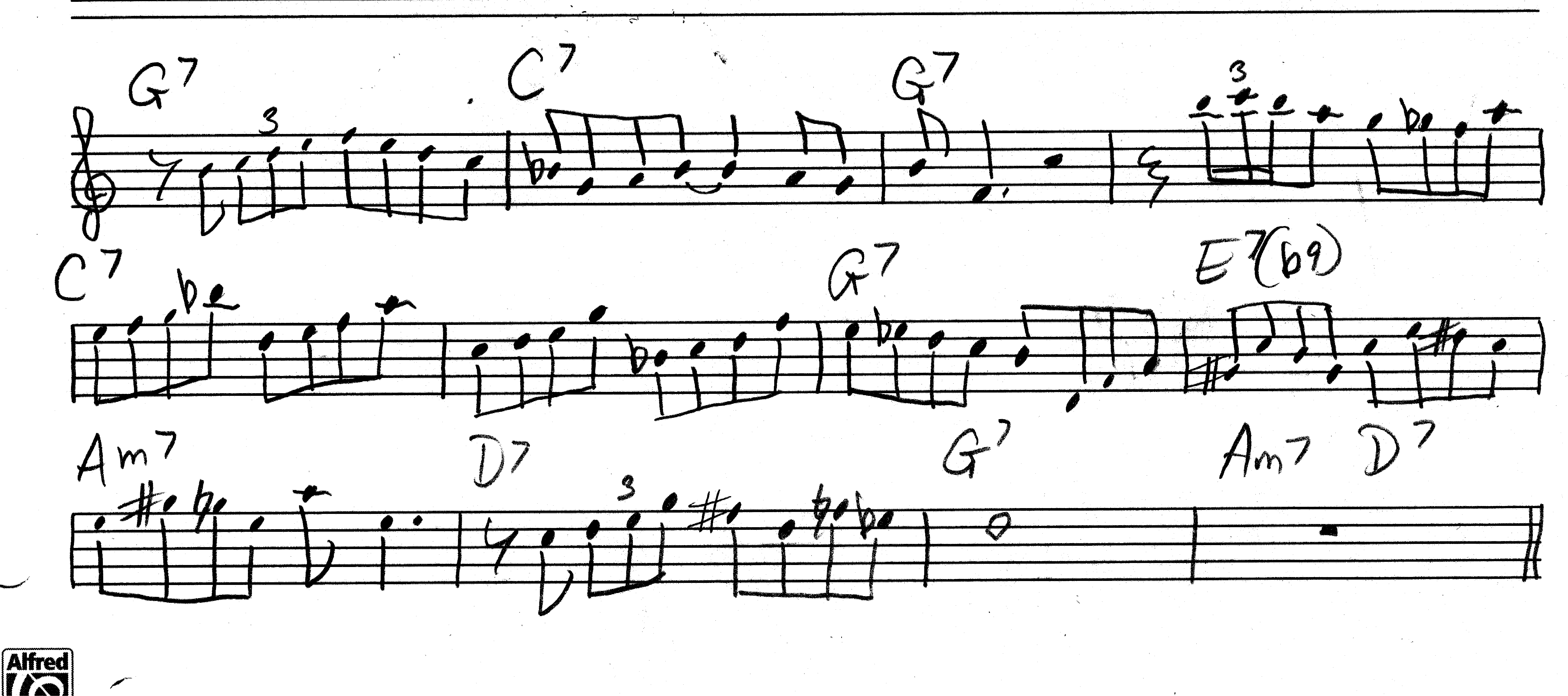Both in print and on the Internet, there’s no paucity of theoretical material available when it comes to “Giant Steps” and Coltrane changes. Of course, theoretical knowledge can’t take the place of time in the woodshed hashing out the changes on your instrument. But it can help you make some sense of what you’re practicing by revealing the order in what can at first seem like an odd, rambling array of chords. Once you understand some of the voice leading in “Giant Steps,” you’ll be able to pinpoint certain guide tones and use them effectively in your solos.
This post is by no means intended to offer an in-depth explication of “Giant Steps” theory. All I’m going to do is call your attention to how a few select tones proceed, so you can be mindful of them for the reason I’ve just stated. Let’s begin by naming the changes to the first four bars of section A in “Giant Steps.” In concert pitch, they are: Bmaj7 D7 / Gmaj7 Bb7 / Ebmaj7 / A-7 D7.
The second four bars repeats that chord progression a major third lower, thus: GMaj7 Bb7 / Ebmaj7 F#7 / Bmaj7 / F-7 Bb7.
If you delete the last two bars in each four-bar phrase and crunch together the remaining chords, you get the following sequence: Bmaj7 D7 / Gmaj7 Bb7 / Ebmaj7 F#7. This is the essential Giant Steps cycle. As you can see, once you reach the end of the cycle it repeats itself as the F#7 resolves downward by a fifth to the Bmaj7.
So far, so good. Now let’s see what happens when we start moving some basic chord tones. We’ll start with the root of the Bmaj7 chord. If you move it down by a whole step, you wind up on the note A, which functions as the fifth of the next chord, the D7. Move A down another whole step and you land on the root of Gmaj7. Continuing down by whole steps in this manner–in other words, moving down the B whole tone scale–will move you from root to fifth to root to fifth through the entire Giant Steps cycle.
You can also apply the same down-by-major-second movement starting on the fifth of the Bmaj7, which is F#. In this case, the fifth moves down a whole step to E, which functions as the ninth of the D7 chord. (You could also look at it as the fifth of an A minor chord that serves as the ii/V7 to the D7.) This note in turn moves downward to the fifth of the Gmaj7. Again you’re descending through a whole tone scale, this one beginning on the fifth of the Bmaj7.
So if you want a handy memory aid to help you organize your guide tones in the Giant Steps cycle, simply think of two whole tone scales (using half notes to match the harmonic rhythm), one descending from the root and the other from the fifth of the Bmaj7 chord.
When you spotlight the third of the major seventh chords, things get more interesting. The third of the Bmaj7 is D#. Moving down a half step lands you on the note D, which is the root of the D7. To get from there to the third of the next chord, Gmaj7, you have to jump down a minor third. When you extend this downward movement of half step/minor third throughout the entire cycle, you wind up with an augmented scale.
You also get an augmented scale when you use the same movement starting on the seventh of the Bmaj7 chord, thus: A#, A / F#, F / D, C#.
To recap:
* For voice leading from the root and fifth of the major chords in “Giant Steps,” consider using, respectively, the B and F# whole tone scales.
* For voice leading from the third and seventh, use the D# and A# descending augmented scales.
I hope these concepts will help you see the symmetry in Coltrane changes and make life easier for you as a result. If you want a resource you can take into the practice room with you to help you master “Giant Steps,” check out my book The Giant Steps Scratch Pad. It’s available in C, Bb, Eb, and bass clef editions. See below for ordering info.
Happy practicing! Oh, and be sure to visit my jazz page for plenty more tips, solo transcriptions, exercises, and articles of interest to jazz musicians.
The Giant Steps Scratch Pad
.
Instant PDF download, $9.50
C edition 
Bb edition 
Eb edition 
Bass clef edition 

Print editions–retail quality with full-color cover, $12.95 plus shipping: order here.





